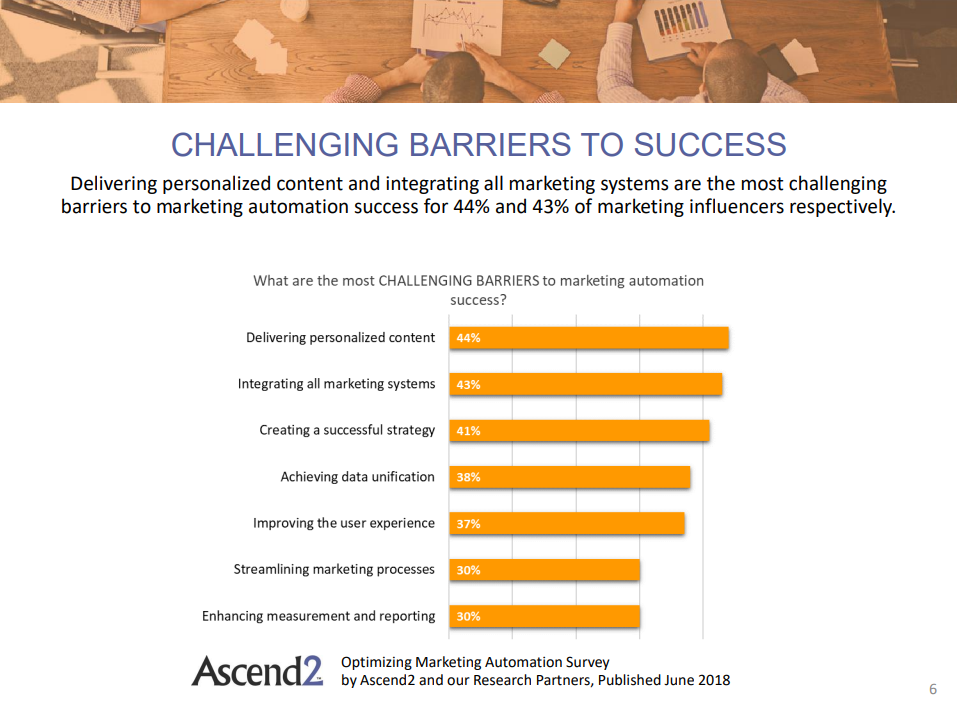Automation has become a key part of everyday life. From paying bills to carrying out routine business processes, it’s increasingly difficult finding places to speed up tedious tasks.
Recently, marketers have taken to using an automation workflow to improve their campaigns. But, businesses should be slightly wary of using it. Automation is seen as depersonalizing and losing the human touch that makes companies stand out from the crowd.
However, automation excels at processing vast pools of data, performing repetitive tasks, and predicting behaviors – making it ideal for vital, time-consuming marketing tasks and gathering important customer insights.
So, how do you marry automation and personalization when improving your marketing campaigns?
Here, we’ll go over marketing automation, personalization, their benefits, and how you can make them work together.
What is personalization in marketing?
Personalization is providing your customers with relevant marketing content and materials to provide better customer experiences. It enables you to boost engagement, loyalty, sales, and retention by making customers feel valued.
Personalization works well when businesses know the needs, interests, and demographics of their desired audience. With this information, they’re able to target current and potential customers effectively.
For example, to reach more customers in Australia, you may consider using au domains to stand out and provide a personalized site for your Australian customers.
How to make automation and personalization work together
1. Define your audience first
A well-defined target audience allows marketing efforts to target the B2B companies interested in your products and services. It’s the first step in building a digital marketing automation strategy.

2. Consider personalizing according to customer segmentation
Customers purchase products based on their needs. Therefore, dividing customers into groups based on their common traits allows for a better-targeted approach when targeting them. It can be invaluable to B2B marketers to deliver a personalized experience for potential customers.
3. Map out the customer journey
Understanding a customer’s touchpoints in their purchasing journey is essential when you need to identify potential pain points as well as see where to apply your marketing processes and automate them to improve the customer experience and increase conversions.
4. Personalize the content and automate processes in the customer journey
Based on customer interests and needs, personalize content for each segment of your target audience. Look at where in the customer journey personalization will be effective and see if you can automate it.
5. Combine personalized and automated messaging
Automation can analyze individual customer interests and send dynamic emails with customized content for each customer. This is another reason, why you need purchase-to-pay automation. For example, customers interested in website themes could be sent website personalisation examples and guides to spruce up their site.
6. Use automation and personalization in your customer support
Customer support deals with repetitive questions from customers daily. Using solutions like an automated chatbot builder can alleviate the burden on support teams and provide quick assistance for common problems and questions.
For example, a chatbot can direct customers asking what is ai domain to a resource page or provide a definition, without human intervention.
But, if the issue proves too challenging, chat widgets can redirect inquiries to human employees, providing effective personalized support. Then, you might also want to consider using an auto dialer to automatically connect customers with an available agent. For this, you can use efficient time-tracking apps and check the productivity of your team.
7. Use automation to gather insights for personalization
Data analysis is vital in providing personalized customer experiences, such as email marketing or optimizing websites for different devices.
Automation excels in processing large pools of data faster than humans. It lets you gather insights in real-time and provide instant personalization based on customer needs, for example, or relevant product recommendations.
Benefits of having an automation and personalization powerhouse
It brings your customers together
Instead of interacting with your customers individually or on different platforms, automation brings them together and delivers personalized experiences based on their interests.

It boosts the quality of your marketing campaigns
Automation can track customers’ interests and behaviors. With this information, it can disseminate personalized content, much like in email marketing and SMS marketing, but target them better.
Additionally, with marketing automation tools like Intercom (or Intercom alternatives), campaigns can scale up to reach a larger target group. With more personalized, cold emails and an email checker to confirm address validity, sales automation can increase the chances of generating leads and conversions.
It attracts more quality leads
Automation can create customer profiles and determine which products or services a customer is likely to buy. Using this data customers can automatically be sent personalized content on the products they’re interested in.
By creating specific content for a segment of your audience, you can generate and attract higher-quality leads, improving sales and retention. You can use Hootsuite alternatives for scheduling your content specifically for your target area and increase your engagement and generate quality leads as such as well.
It churns out valuable and high-quality data
Data is vital to providing a seamless, personalized customer experience. Automation can measure and process vast amounts of data quickly, providing actionable insights about customers at speed.
Furthermore, automation provides more accurate insights as it collects additional data. It allows you to predict patterns and trends, providing you with an edge over your competitors.
It helps handle customer queries
Using AI chatbots, virtual assistants or virtual machine automation can cater to customer needs 24/7 as it never needs a break, ensuring your customers have a brilliant experience. Additionally, by taking care of repetitive customer queries, your human teams are free to spend more time dealing with complex customer issues.
Automation provides reliable support experiences that can drive customer recommendations, retention and increase their satisfaction.
It eases the workload
With automation taking care of repetitive tasks, your marketing team doesn’t have to worry about executing a simple marketing process, such as sending remarketing emails or collating data for analysis. Instead, they can think creatively and work on new marketing campaigns to improve conversions and reach more customers.

Why are businesses afraid of automating onboarding
Simply put, onboard automation means utilizing automation techniques to get onboarding workflows going easier. It connects to various platforms such as email, apps, and other communication methods to make sure the onboarding process is as streamlined and centralized as possible. An onboarding checklist can also help you create a good onboarding, and this makes for a happier workforce.
Despite this promising concept, businesses hesitate from using this because of the “automation” aspect. Businesses aim to provide customers with the best experience during their buying journey. It involves providing a human touch in creating personalized content and making customers feel appreciated. A good customer relationship is essential to build customer loyalty and achieve success.
When it comes to automation, businesses are afraid they’ll lose the valuable human element in their marketing strategy leading to depersonalization and a less enjoyable customer experience.
Another big concern is control. Automation takes over routine, repetitive tasks, and analysis that are important to a marketing campaign. The idea of letting an algorithm or machine handle them is unsettling for a marketer or business owner who wants to be involved in every stage of the process.
However, with automation, marketing teams can direct their attention to more important complex tasks, improving productivity. For example, they could focus on building an affiliate marketing sales funnel to increase ROI and improve brand reputation.
Automation through a customer engagement platform can help sales teams to effectively target their efforts and improve personalization while continuing customer engagement. This allows sales teams to focus on what matters most by creating tailored campaigns for their customers and providing a seamless experience. By leveraging automation, sales teams can create more value from customer engagement and create an improved customer experience.
A few tips when implementing automation and personalization together
There are many ways to use automation and personalization together to boost engagement, conversions, and customer loyalty. For example, using automation to add customers’ names to emails makes them feel valued and increases the chance they’ll open it.
A few more tips for implementing a digital marketing automation solution include the following points.
Time your messaging
Your customers could be anywhere in the world. With varying time zones, it’s vital customers get their emails at the right time, or they could get lost in their inbox.
Use insights gathered with automation to see where your customers are and when they’re active to personalize when you send your message.
Use personalized sites
You can do a quick domain search to find a domain name that differentiates who you are and where you’re located. Instead of one, general global site, you could use domains, like an ae domain, to personalize the customer experience.
An ae domain defined as the country code Top-Level-Domain for the United Arab Emirates can automatically reroute traffic from the UAE to this domain and help you provide personalized information to customers.
Use relevant themes
Sending automated emails themed around the time of year, the holiday, or even the weather outside can engage and build relationships with customers. With personalization like this, your business suddenly feels much closer, allowing your customers to connect, helping to build customer loyalty.

Don’t overdo it
Overly personal emails that arrive too often can put customers off. Consider your automation workflow and how best to reach out to your customers through personalization. The key is to balance being consistent with sounding genuine in order to boost your credibility to customers.
Start your successful personalized automation strategy
Personalization is essential in interacting with customers and making them feel valued. The importance of personalized content on your website or in emails can’t be understated. It boosts engagement, loyalty, sales, and retention, giving you an edge over your competitors.
Using automation, you can boost your marketing efforts by expanding the scale of your campaigns and better targeting customers for increased B2B conversions.
Automation takes care of the repetitive tasks holding your marketing and sales team back, ensuring they’re free to dedicate their time to more creative avenues, like developing lead generation tactics to find more paying customers.
With added data collection and analysis, automation can improve the customer experience and provide insights for increased personalization.
There are many ways to combine automation and personalization. By analyzing your customer journey, you can discover the right strategy to improve your marketing process and develop successful digital marketing automation and personalization strategy.


